
Blue Chalk Sticks
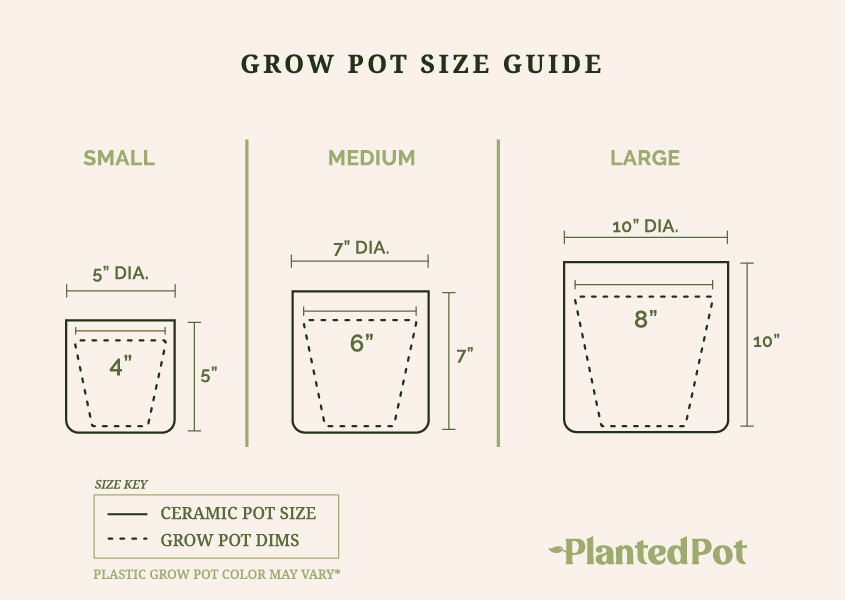 Plastic grow pots come in different colors, you may receive a black or rust colored pot.
Plastic grow pots come in different colors, you may receive a black or rust colored pot.
The Succulent Blue Chalk Stick’s name tells you everything you need to know about this pretty plant: its leaves resemble sticks of blue chalk! Native to South Africa, the succulent’s many finger-like leaves stretch towards the sky as the plant spreads across the ground. The Blue Chalk Stick isn’t picky when it comes to its container or conditions. Unlike many house plants, the Blue Chalk Stick grows in the winter and is dormant during the summer. The two biggest things to avoid with your Blue Chalk Stick are shade and frost. Even though these plants thrive during the winter, a freeze will limit any plant’s growth. With the right care, these funky beauties will make your garden stand out from the rest!
6 hours of bright, indirect sunlight per day. Direct sunlight may give it a slight sunburn, but it won’t dramatically harm these resilient desert plants.
Soak your plant deeply every three or four weeks, but let the soil dry out completely between watering sessions.
65°-75°F At the lowest, it can handle 20° F, but won’t survive consistent temperatures below freezing.
Related Products
Blue Chalk Sticks
They’re blue, they’re green, they’re blue-green – they’re a color you can’t quite put your finger on, but that’s what people love about them. They’re Blue Chalk Stick succulents!
Blue Chalk Sticks are hardy succulents that can grow indoors as a houseplant or outdoors as ground cover. They have enough allure to be a standalone plant or can be the perfect complement to other plants. If you’re looking for another succulent, look no further than the versatile and beautiful Blue Chalk Stick succulent!
What is a Blue Chalk Stick Plant?
The Blue Chalk Stick plant is a succulent native to South Africa, known for its powder blue-green color and thick finger-like leaves that grow pointing upwards. They’re often found in outdoor gardens as a low-growing ground cover to add some texture and variety. Additionally, their subtle color does a very good job of highlighting the bright colors of surrounding plants.
Their eye-catching color is perhaps most appreciated as a standalone houseplant because their muted color can fit into almost any color scheme. Blue Chalk Sticks might just be the missing splash of color your home or living space needs.
Blue Chalk Stick Variations
There are actually two varieties of this plant. Both plant variations have a similar shape and are blue or green but differ in their size.
The traditional variation is Senecio mandraliscae, which is the larger of the two and has a slightly bluer color. It can grow up to 18 inches tall and is characterized by 3 to 4 inch long leaves arranged in a dense pattern. This variation tends to grow more vigorously and sprawling, which is why it is often found outdoors.
The other variation (which we carry here at Planted Pot) is Senecio serpens, also known as the mini Blue Chalk Stick or simply Blue Fingers. This variation is more suited as a houseplant because of its compact size and tidy growth pattern. However, it can also survive outdoors and provide smaller-scale ground cover. It grows to only 6 to 12 inches tall and has 1 to 2 inch long, fleshy leaves in the distinct blue-green hue Blue Chalk Sticks are known for.
History of Blue Chalk Sticks
The Blue Chalk Stick succulent (Senecio serpens) is native to the Western Cape province of South Africa and was first cultivated in 1710. It’s smaller and slower growing than its variation, Senecio mandraliscae, and produces small white flowers in the summer.
The name “senecio” is from the Latin word “senex,” which means “old man” – a reference to the way the seeds look like the puffy white hair of an old man.
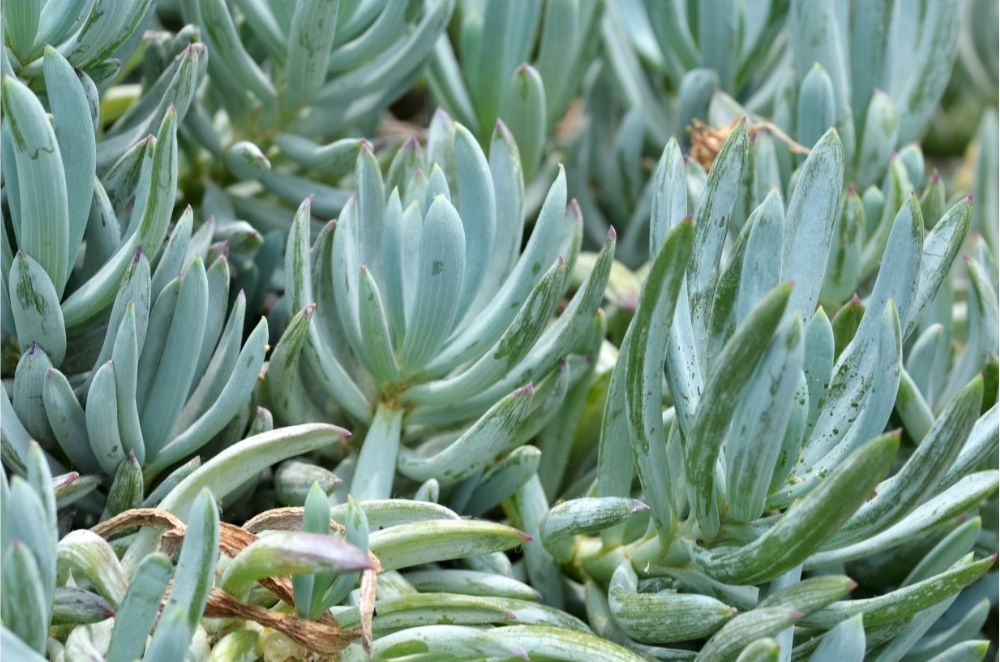
Blue Chalk Stick Plant Care
As a succulent, Blue Chalk Sticks are made to endure long periods of little to no water. They’re hardy, and even if you neglect them once in a while, they will live on (and won’t hold any grudges!).
Here are some quick plant care tips:
- Plant size: Small/medium; grows to around 6 to 12 inches tall with a possible spread of 2 to 3 feet wide (however, they will be much smaller if contained to a pot)
- Light: Thrives in full sun for 6 to 8 hours a day but can also grow in partial shade with indirect bright light
- Water: Soak deeply every 3 to 4 weeks; if indoors, water once a week or when soil is completely dry throughout the container
- Soil: Well-draining succulent soil with 50 to 70% mineral grit to ensure proper drainage
- Temperature: USDA plant hardiness zones 10 through 11; prefers warmer climates higher than 65°F, but can survive as low as 20°F
- Bloom: Small, white flowers that bloom in summer
- Growth Cycle: Actively grow in winter and go dormant in summer
Why Choose Blue Chalk Sticks for Your Home?
Blue Chalk Sticks are a fantastic choice for your home for many reasons! Here are just a few:
Unique Color
There are other spiky succulents out there that look similar to Blue Chalk Sticks, but none of them have its unique color. It can be described as blue chalk, powdery green, or muted blue-green (sometimes even with a silver haze), but whatever you describe it as, there isn’t anything like it.
Versatile
Indoors or outdoors, in a pot or in the ground, Blue Chalk Stick plants can thrive almost anywhere. This versatility makes it a very versatile decor, and it can be that splash of color or texture your home needs.
Also, the appealing (but muted) blue-green color can easily blend in with other colors. This South African plant works particularly well when contrasted with other brightly-colored flowers or leaves.
Resilient
Succulents are naturally resilient and can handle almost anything that’s thrown at them. Here are some reasons why they’re some of the hardiest plants out there:
- Can handle harsh conditions: Inconsistent watering, partial shade, and dry soil doesn’t faze them! With proper care, they can bounce back very quickly; so, no one will know that you forgot to water them for a month.
- Few pests: Succulents typically don’t have many pests or diseases because bugs tend to stay away from their thick leaves.
- Fire-resistant: Succulents are naturally fire-resistant because of how they store water in their leaves and stem.
Are Blue Chalk Sticks Good Indoors & Outdoors?
Yes! Although they are more often found outdoors, Blue Chalk Sticks can also be great indoor plants. Put one in a pot with proper drainage and succulent soil, and it will thrive. They are small enough to be accent plants, perfect for decorating your office desk or coffee table. Just make sure to move them to the window (or outside) once in a while, so they get enough sunlight.
As an outdoor plant, they have a plethora of uses:
- Ground cover to add color and texture to a garden
- As a border plant to accentuate walkways or edges
- As a complement to other bright-colored plants and flowers
- In a rock garden
- As an element in a succulent container
Are Blue Chalk Sticks Pet and Children Friendly?
No, Blue Chalk Sticks are toxic to pets and people. Most of the time, kids and pets won’t eat them, but it’s best to keep it away from curious hands and mouths in general.
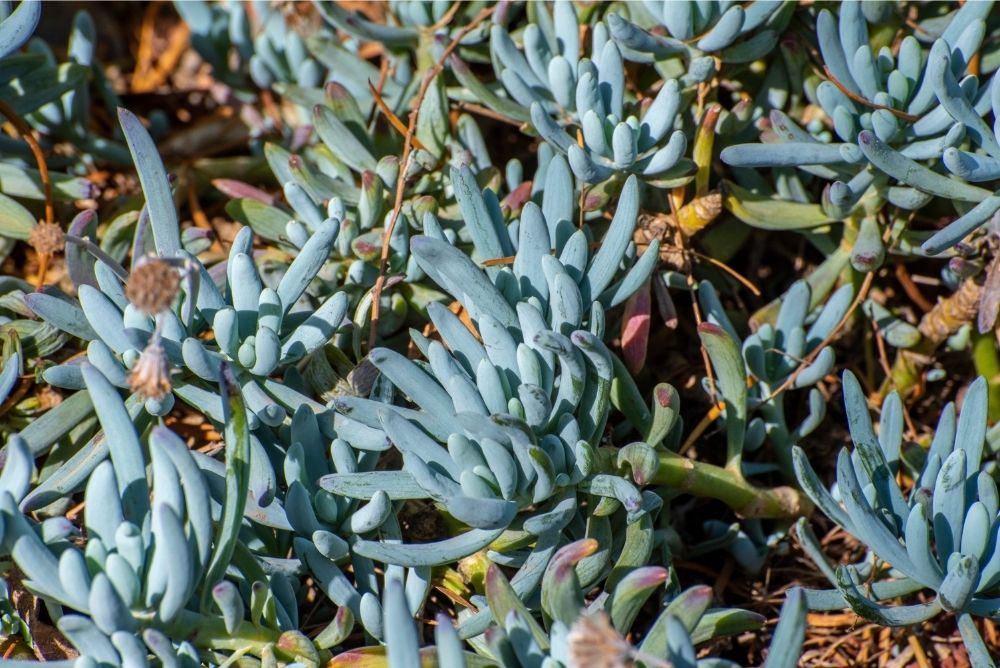
Blue Chalk Stick Family Relatives
The Blue Chalk Stick succulent is from the Senecio of succulents, which hail from South Africa and have daisy-like flowers and seeds that look like small puffs. Senecio plants typically don’t do well in frost (lower than 20°F) and actively grow in the winter season.
Some of its relatives include:
- Senecio mandraliscae: This plant is its closely-related, bigger cousin that has the same name
- Senecio peregrinus: Also called String of Dolphins; it’s known for its long, thin stems, dolphin-shaped leaves, and beautiful cascading look perfect for hanging pots
- Senecio scaposus: Known for its bean-like leaves and fuzzy, silver outer covering that protects it from the sun (and naturally peels away!)
Plants That Are Similar to the Blue Chalk Stick
Looking for a plant similar to Blue Chalk Sticks? Try out these!
- Aloe Vera: This might be the most well known succulent because of its moisturizing properties; it has iconic thick, spiky leaves that house a healing gel – which might be exactly what you need if you get too much sun
- Haworthia (Zebra Plant): Another spiky succulent with eye-catching white stripes reminiscent of a zebra
- Snake Plant: A hardy succulent with long, sword-like leaves and a deep green color; it’s very popular in offices and homes alike
Final Thoughts – Blue Chalk Stick Plants
The Blue Chalk Stick plant is the succulent you didn’t know you needed. It’s subtle but unique, unappreciated but necessary. With a powdery green-blue hue, it’s beautiful enough on its own and can be a standalone houseplant. However, the color really shines when paired with other elements. It’s wonderful at enhancing the vivid color of other plants, bordering a walkway, or bringing out the beauty of your home decor!
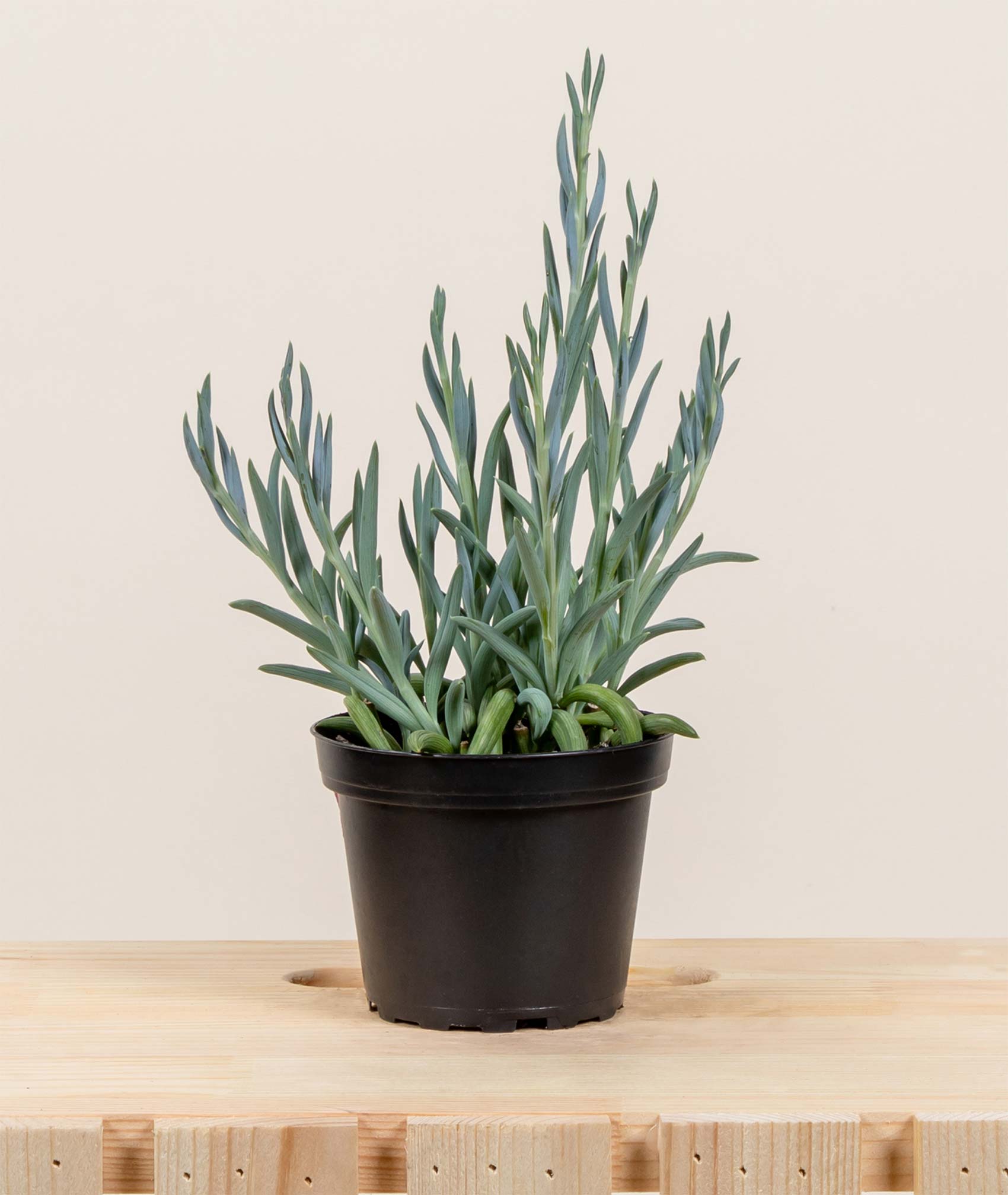
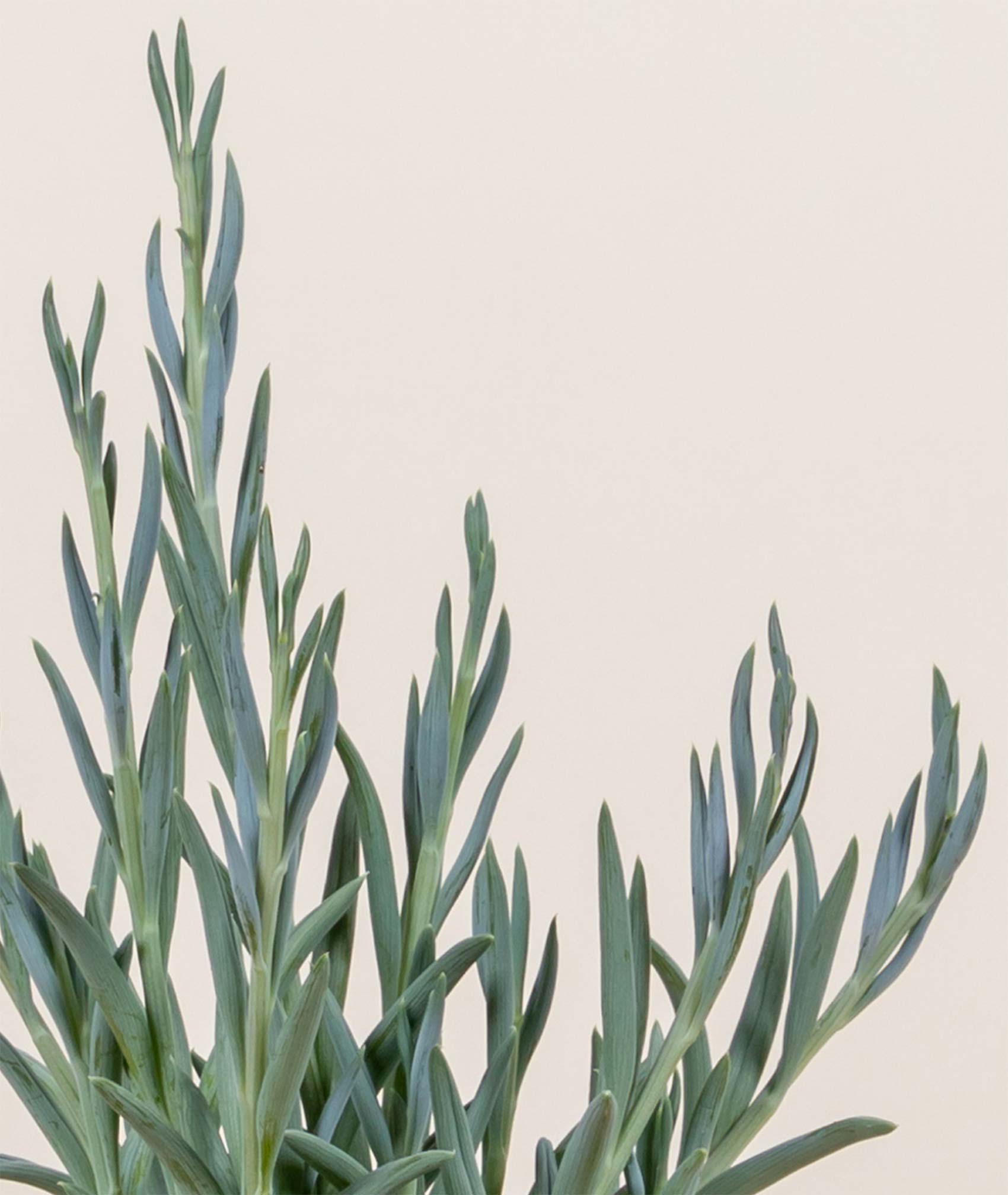


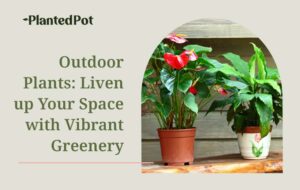
Reviews
There are no reviews yet.